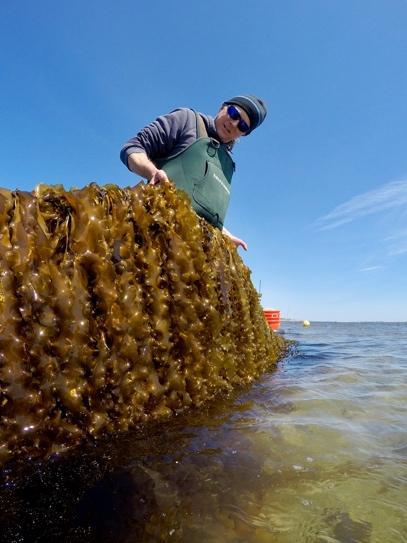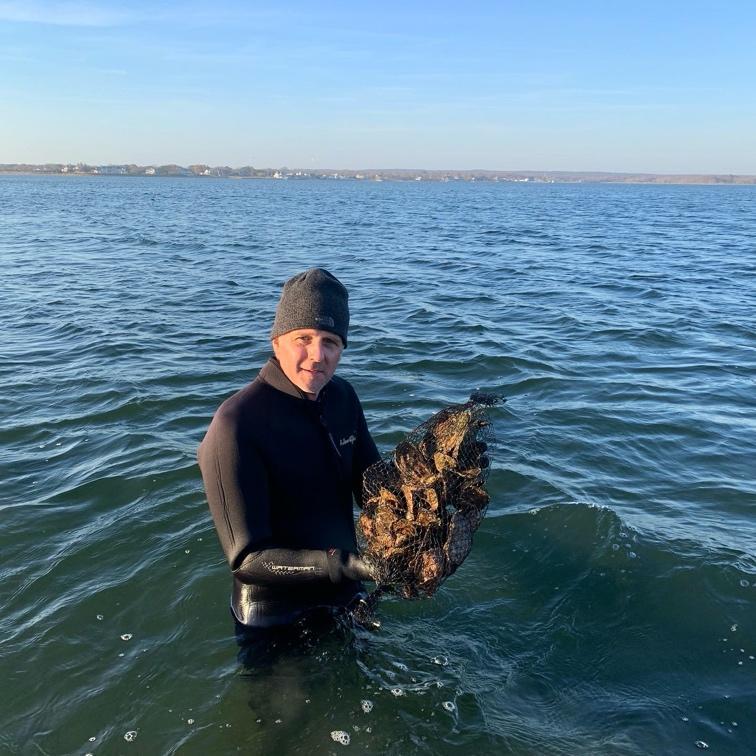Kelp is on the way: How one scientist is using seaweed and oysters to save our coastal waters and communities
This is part of a three-part series on mariculture in the United States.
By Candice Powers, COL’22 & Maine Aquaculture Pioneers Program Intern

Ocean farmer Michael Doall manages a kelp rope in the waters off Long Island, New York – Photo provided by Michael Doall
For Michael Doall, the salty waters surrounding Long Island have long harbored promises for exploration and entertainment. Growing up along the coast, Doall spent countless days fishing, surfing, and swimming at the beach, partly because his mother let him skip school on especially lovely spring afternoons. “From birth, one of my passions has been the ocean,” Doall says, a lasting enthusiasm that ultimately led to his career in regenerative aquaculture and shellfish restoration. While his days of skipping class to bum it at the beach may be over, you can still find Doall in the bays of Long Island, dedicating hours to researching and restoring the marine organisms that provide innumerable benefits to the ecosystem he calls home.
When Doall began studying marine biology, regenerative aquaculture—the farming of marine species in open waters to bolster habitat quality—was far from common in the U.S. However, having always had gardens growing up, Doall found that the field of ocean aquaculture brought together his passions for the ocean and cultivation.
Doall was first exposed to regenerative aquaculture 20 years ago when The Nature Conservancy started a hard-shell clam and oyster restoration program in Long Island’s Great South Bay and reached out to Doall for his analytic expertise. Bivalves, such as clams and oysters, are essential to ocean ecosystems. They suck up excess nutrients and sediment from waterways, improving water quality and preventing harmful algal blooms. At The Nature Conservancy, Doall grew shellfish in cages across the bay to study how different marine environments would support these species.
There, he realized how much he enjoyed growing the oysters and rebuilding marine ecosystems, so he dove deeper into open-water aquaculture by establishing some of the first oyster restoration projects in New York Harbor (NYH). While first working at these sites, he aimed to use oysters solely for environmental purposes—the harbor’s pollution meant organisms wouldn’t be safe for consumption. Later, however, he had “the epiphany that oysters do the same thing in an aquaculture setting as they do in nature.” By growing oysters for human consumption, these filter feeders would naturally improve water quality by consuming excess nutrients while providing a sustainable source of fresh seafood.
By growing oysters for human consumption, these filter feeders would naturally improve water quality by consuming excess nutrients while providing a sustainable source of fresh seafood.
Inspired, in 2008 Doall started his own oyster farm: Montauk Shellfish Company. He took a lot of pride in being an oyster farmer, stating that “one of the most important activities you can do is to grow food and feed your community.” And that’s exactly what he did. Doall was on the cusp of an “oyster renaissance” and would soon witness Montauk take off beyond his expectations.
Doall would next discover the missing piece to make his project sustainable: kelp. During his time as an oyster farmer, Doall visited Maine where he learned from the first U.S. kelp farmers that by diversifying his crop to include kelp, which has an opposite growing season to oysters, he could complement his shellfish operation (kelp in the winter, shellfish in the summer).
The relationship between kelp and oysters would later inspire Doall’s research. After selling his farm in 2017, Doall still considers himself a farmer in his current role as Associate Director for Bivalve Restoration and Aquaculture at Stony Brook University. Doall combined his experience in cultivating both oysters and kelp in his new role to create a marine-cleaning superteam to counteract eutrophication that has long plagued Long Island.

Oysters cultivated for their taste, and the health of the ocean – Photo provided by Michael Doall
Like oysters, kelp sucks excess nitrogen out of the water, helping to keep our oceans clean. Kelp also captures carbon dioxide from the water column as it photosynthesizes. Harvesting the kelp then removes carbon from the ocean, making the seaweed an important tool for combating harmful ocean acidification. Unfortunately, Long Island does not yet allow kelp farming due to a decade-long battle surrounding permits. Nonetheless, Doall has been able to implement research projects over the last four years dedicated to bringing the benefits of kelp to the area.
Through one such research project, Doall developed a specialized technique for growing kelp in the shallow coastal waters of Long Island, as opposed to traditional kelp farming done in much deeper waters. He was impressively able to grow 12-foot-long kelp fronds in only two feet of water. This compact feat can help not only shallow-water ocean farmers, but also other species residing in shallow bays, where poor water flow otherwise means poor water quality.
The nutrient-extraction capabilities of kelp are especially important in Long Island. As Doall says of his hometown, “Long Islanders love their lawns and golf courses.” He tells me about the truckloads of fertilizer that are brought in during the warmer months, dumping nitrogen all across the island. A farmer at heart, Doall envisions growing forests of kelp along the coast to absorb the nitrogen runoff from shore. Once harvested, this kelp can be developed into nitrogen-rich fertilizer packed with other micronutrients and biostimulants that can be used throughout the community. It would be a closed nitrogen loop, lowering the demand for imported fertilizer and delivering environmental and economic benefits to the island. Doall plans to explore such a system’s feasibility this summer through garden studies on kelp-based fertilizer’s benefits.
Along Doall’s journey to restore his local ecosystem, he encountered a variety of challenges. Despite support from large environmental groups such as the Nature Conservancy and Pew Charitable Trust, regenerative aquaculture must compete with a variety of stakeholders on the water. Recreational boaters, commercial fishermen, and even windsurfers have opposed Doall’s projects.
“In the end, all these groups recognize the value of regenerative farming, but a lot of people don’t want it in an area where they’re doing something,” he says. There is also a so-called “social carrying capacity” for aquaculture: as soon as over ~5% of the coastline is occupied by ocean farmers, “people start freaking out” and are quick to complain about the oyster farms visible from their backyard. Nevertheless, Doall has found that a healthy, bustling ocean can unify disparate marine interests.
At the end of the day, Doall believes in his mission to support ocean farming and rebuild shellfish populations in his home waters. While he knows these nature-based projects are not the only climate solutions, the benefits of regenerative aquaculture and shellfish restoration cannot be ignored. Aquaculture projects secure jobs and income while nutrient bio-extraction revitalizes the ecosystem, a win-win for coastal economies and environments. Moreover, because of overfishing and marine habitat degradation, fishing communities that have long relied on the ocean for their sense of identity are losing their cultural ties. Luckily, according to Doall, “regenerative aquaculture is a way to bring that cultural identity back…so there’s a win-win-win.”
You will always find Doall working away in the waters of Long Island, happy as a clam, because, “When do you plant a victory flag? Never.” The fight for climate-resilient solutions never stops, but local, restorative projects such as Doall’s continue to provide hope for a greener future.
